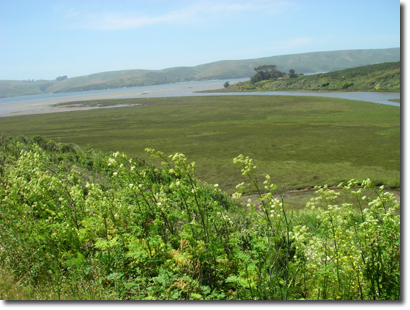Tomales Bay Mercury TMDL
Tomales Bay is listed on the Clean Water Act 303(d) list of impaired water bodies for mercury. The biggest anthropogenic source of mercury to Tomales Bay is the former Gambonini mercury mine, which was cleaned up in 2000. As a result, mercury concentrations at the Walker Creek Delta in Tomales Bay, downstream of the mine have decreased. Additional implementation actions are underway as a result of the Walker Creek watershed mercury TMDL, particularly the grazing waiver (also required by the Tomales Bay pathogens TMDL). Therefore, the TMDL does not require new management actions. New - April 2024 Report on Tomales Bay 2022 Biota and Sediment Mercury DataIn 2022, Regional Water Board staff collected prey fish, shore crabs, and sediment samples from Walker Creek Delta and Millerton Point to compare mercury concentrations from a site polluted by a mercury mine (Walker Creek Delta) to a site without local mercury contamination (Millerton Point). The mercury concentrations in biota appear not to have decreased despite sediment concentrations at Walker Creek Delta being reduced by more than 50% due to the Gambonini mine cleanup conducted by the U.S. EPA. The trends are not clear for biota data collected at Walker Creek Delta. Methylmercury concentrations in striped shore crabs at Walker Creek Delta are significantly greater than concentrations in striped shore crabs at Millerton Point. However, the methylmercury concentrations in green or yellow shore crabs from Walker Creek Delta were not significantly different from those caught at Millerton Point. There is not yet conclusive evidence that methylmercury concentrations are increasing or decreasing as a result of TMDL implementation actions. Status and Public Notices
Adopted Resolution and Supporting DocumentsTechnical Documents
BackgroundThe Bay is located in the Gulf of the Farallones National Marine Sanctuary, and is renowned for its wildlife, fishery and shellfish. In their stewardship plan, the Tomales Bay Watershed Council describes:Hundreds of species of mammals, birds, invertebrates and plants, and many threatened and endangered species inhabit the watershed, which is also an important foraging and haul out site for marine mammals and over-wintering area and migratory stop along the Pacific Flyway for many species of birds, including approximately 20,000 shorebirds and 22,000-25,000 waterfowl. For More Information Contact:Gerardo MartinezWater Resource Control Engineer San Francisco Bay Regional Water Quality Control Board 1515 Clay St., Suite 1400 Phone: (510) 622-1015 Fax: (510) 622-2460 E-mail: Gerardo.Martinez@waterboards.ca.gov | ||



